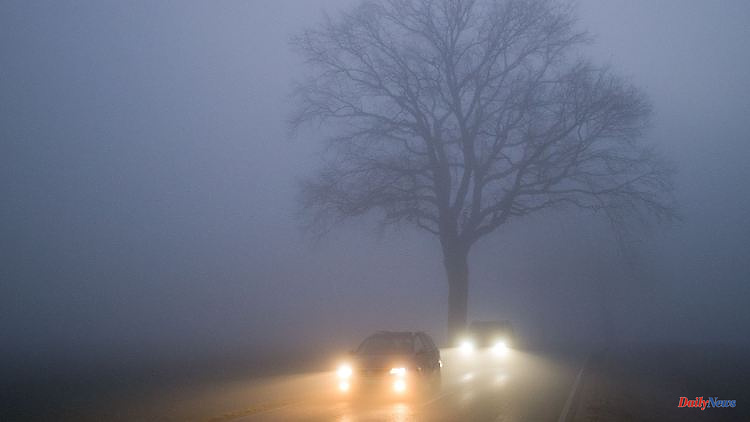The days are getting shorter and the nights cooler. Drivers should now prepare their vehicle for autumn and winter to avoid a rude awakening.
The cold season is always good for surprises. Anyone who drives to work in their car early in the morning must definitely expect to suddenly find themselves in a wall of fog. If the air is damp after showers and then calms down quickly, a thick layer of fog can form with visibility of less than one kilometer. "That can be treacherous for drivers," says Sebastian Wache from the Wetterwelt weather service in Kiel.
The nights and cooler air masses from the higher latitudes could then also cause the first ground frosts. "The change to winter tires should therefore slowly come to the back of the minds of vehicle users," advises Wache.
Seeing well and being seen well is the most important thing on the road. As the days get shorter, the low beam should be switched on early.
According to Dekra expert Stephan Schlosser, a fully functioning, correctly adjusted lighting system is a must, especially in the dark season. "Blenders, one-eyed and obscure men repeatedly cause unnecessary irritation in traffic."
Thorough cleaning of the windshield inside and out is also helpful. In addition, the windscreen antifreeze should now be refilled with the wiper water.
The Auto Club Europa (ACE) recommends a thorough check of the wiper blades in winter. "The wiper blades can become brittle due to heat and UV radiation, and use also leaves signs of wear and tear," says Sören Heinze from ACE. As a rule of thumb, he states: "If streaks remain after cleaning the car windscreen, which do not improve even after cleaning the wiper blades, it is time to fit new wiper blades."
Speaking of perspective: A damp interior is often the cause of fogged windows and quickly leads to poor visibility. However, wiping the windows clear often only helps for a short time.
"A good solution can then be a car dry bag that absorbs up to 500 grams of moisture and keeps the inside of the car dry," says Claas Alexander Stroh from Tüv Nord. However, care must be taken to stow the sack well, because the sacks quickly gain weight due to the amount of liquid absorbed.
The dry bags are available in different sizes from about ten euros. Attention: If the vehicle is moved despite impaired visibility, there is a risk of a fine.
Falling temperatures also put a strain on the vehicle battery, which can then quickly lose capacity. "If the car sits still in the cold for a few days, the battery will gladly refuse to work. Small battery chargers are good helpers then," says Stroh. For a quick jump start, we also recommend carrying a jumper cable in the trunk in the winter.
From October, the tire change should also find a place in the calendar. "The rule of thumb is still: From O to O - so from October to Easter, the winter tires should be on," says ACE specialist Heinze. If you want to do the change in a workshop, you should therefore make an appointment in good time and, if necessary, take care of new tires so that they are then ready for use.
Good winter tires should have at least four millimeters of tread depth. In black ice, snow, slush, ice or frost, according to Dekra, you can only drive with winter tires. Otherwise there is a risk of a fine.
Such tires have been marked with the Alpine symbol (mountain with a snowflake) since 2018. However, there is still a transitional period until the end of September 2024 for older tires with "MS" marking in order to comply with the winter tire obligation.
If you don't want to do it yourself, you can get professional help in car workshops. Most garages also offer full winter checks. "The light test is often even free of charge," says Heinze. A complete vehicle check, in which a lot is checked from the operating fluids to the brakes, usually costs between 20 and 30 euros.
Drivers should also invest in a thorough vehicle wash before winter. "When winter begins, minor damage to the paintwork, dirt and unprotected locks can lead to rust over time," says Claas Alexander Stroh. "An intensive paintwork care and regular cleaning of the vehicle prevent this." The underbody should also be part of the wash to reliably remove salt and dirt.
The basic equipment for the winter also includes the many little helpers that no car should be without. "Ice scrapers, hand brushes and a warm blanket should always be on board to be prepared for frost and unexpected snowfall," says Sören Heinze.
If you want to prevent an icy windscreen, you have to use a thermal cover in the evening. The alternative comes in a can: "A de-icing spray is particularly helpful against stubborn layers of ice and against frozen windshield wipers," says Stroh. If you are in a hurry in the morning, the combination of de-icing spray for pre-treatment and subsequent scraping with an ice scraper is recommended.
In general, Sebastian Wache advises driving with foresight, especially in autumn and winter. "The next autumn storm is bound to come and things can get critical, especially on high bridges," says the meteorologist. "For large and high vehicles, the larger attack surface is a decisive factor that influences the vehicle's handling."
Sleet showers, sleet and snow are also possible very quickly at higher altitudes. "It is now a time when you should definitely adjust your driving speed to the weather conditions and possibly plan a few minutes more time for the journey."












